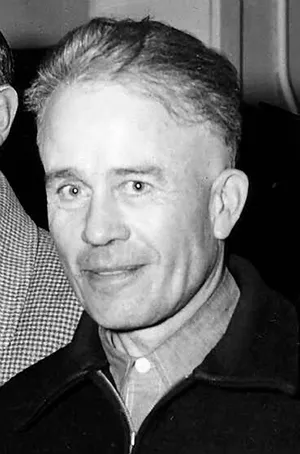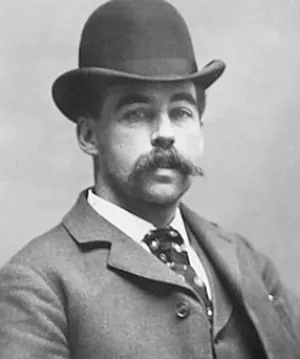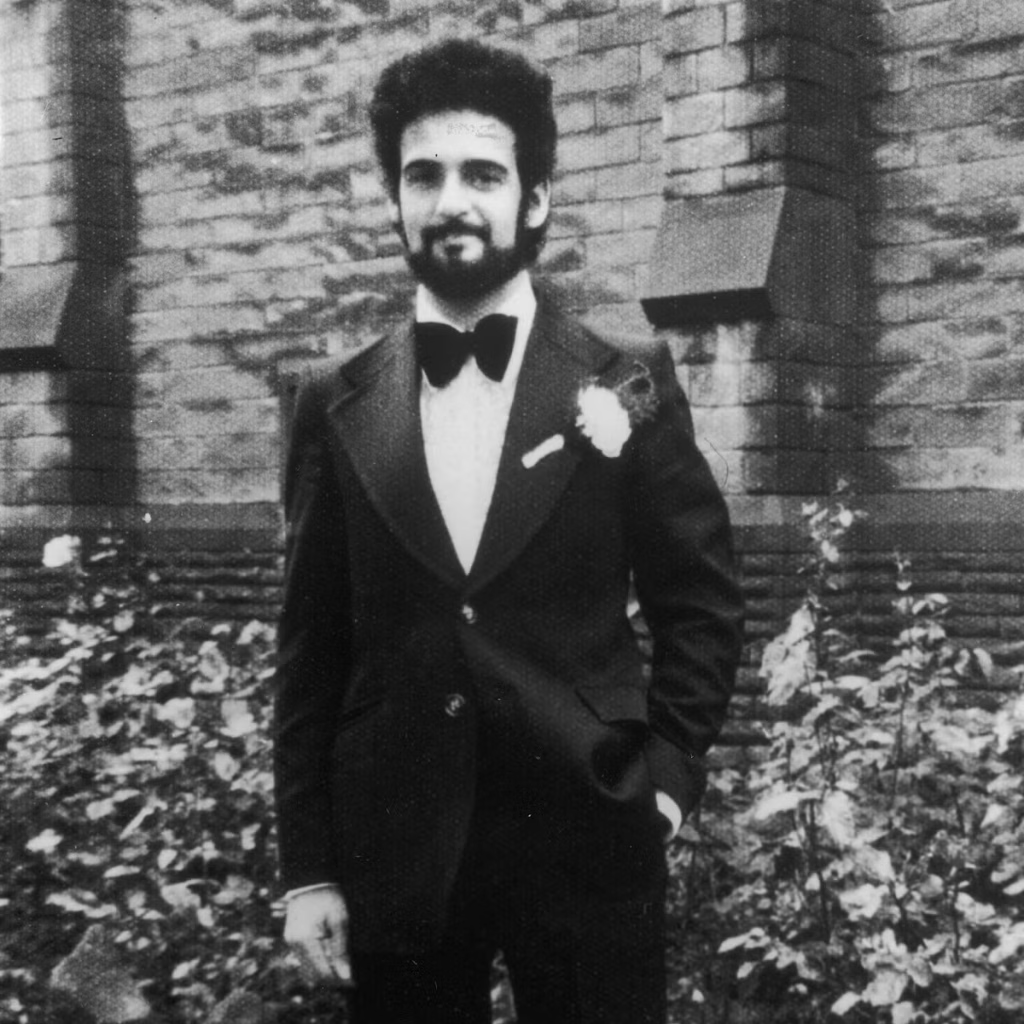Disclaimer: this page contains topics and descriptions that some may find disturbing. Read at your own responsibility.

Ed Gein
Ed Gein was raised mainly by his conservative mother with strict puritanical views. His dad had severe alcoholism problem and Ed’s mother wanted to raise her son to be a better man than his father. The boy was under a strong influence of his mother and idolized her and her beliefs – among things that she taught him was that all women, except for her, are the source of all evil. Aside from going to school, she didn’t let her sons out of their property, afraid of potential harmful influence others might bring onto her sons. This caused Ed to be an object of bullying at school and made him have no friends.
After his family’s death (his father died of heart attack, mother after a series of strokes and his brother in a fire under mysterious circumstances – it’s suspected Ed played a part in his death), Ed was left all alone. Due to long-term isolation, Gein’s unstable mental state worsened, he became deranged. He never saw anything wrong in his mother’s restrictions and without her he felt like he couldn’t be complete. All alone, he began to read obscure and disturbing magazines. From there on, he spiralled down to insanity. During an investigation of disappearance of Bernice Worden, the police discovered her headless body hanging from Gein’s shed’s ceiling together with Mary Hogan’s head who went missing three years prior. There were other deeply disturbing objects found in Gein’s house. After initially denying committing those crimes, Ed finally confessed and was charged on a count of first-degree murder, however, found mentally unstable to stand for trial he was sent to Wisconsin’s Central State Hospital for the Criminally Insane. After Gein was determined sane enough to stand for trial, he was found guilty of murdering Worden and acknowledging his mental state the judges stated for Gein to spend the rest of his life in a mental hospital where he died of heart failure due to cancer.
Theory applications
Trying to explain the enigma surrounding criminal behaviours of criminals such as serial killers, many sociologists like Edwin Sutherland and Walter Miller have created theories that they later applied to those criminals. Gein’s behaviour can be mainly explained through theories such as life course theory, nurture theory, psychodynamic theory, routine activities theory, and social learning theory.
Life course theory – it explains that criminal behaviour maintains stability over lengthy periods of a person’s lifetime and both positive and negative events shape the rest of their behavioural development. One is more likely to have criminal tendencies if they’ve been exposed to problematic transitions in life, usually ranging from precocious sexuality, abusive households and joining gang organizations. Through participating in such activities, especially at a young age, it’s more likely for the individuals to adopt law-violating behaviour and show tendencies towards criminality (Siegel, 2017). The abuse and negligence experienced by Gein from his parents increased his propensity to criminal tendencies later in life. His mother’s restrictions resulted in Gein not having an indirect outlet of frustration that had accumulated because of his situation at home. The death of his family became sort of a trigger for him – he didn’t have limits anymore as to what he could or couldn’t do. Combined with isolation it led him to murdering and mutilating corpses of his victims (Fischer & Ozturk, 2017). However, after his trial Gein never pursued criminal behaviour again, which can be explained by the effect his mother’s teachings had on him – he returned to being his mild-mannered self.
Nurture theory – it explains that the proponents of learning through experiences and one’s environment affects the IQ levels of children and that their behaviour is directly correlated to environmental stimulation from one’s peers, family, education, etc. Abusive environment and factors such as peer pressure or poor performance at school all contribute to entering the path to criminality. This theory was supported by Travis Hirschi and John Bowlby with their own one, Bowlby’s theory of attachment (McLeod, 2017). Gein’s mother’s teachings and perception of women was the source of Ed’s trauma, it directly influenced his violent behaviour when he grew up which included robbing graves and murdering women that resembled his mother. He took her ideals at face value and never realizing the control his mom had over him led him to commit those crimes.
Routine activities theory – presented by Lawrence Cohen and Marcus Felson, claims that availability of targets, absence of authorities, and presence of motivated offenders contribute to increased number of victims. In the case of Gein his targets were easy to access as most of them were bodies exhumed from a graveyard and his two murder victims, Bernice Worden and Mary Hogan, were alone at the time of Ed’s attack. Lack of authorities as well as his home being vast, isolated farm with no supervision from neighbours gave him a lot of freedom with what he could do. Moreover, in the town he was perceived as kind and mild-mannered man, which drove any suspicions away from him, however, his antisocial personality and unstable mental state were also important when analysing the reasoning behind his crimes; Gein was essentially a motivated offender.
Cognitive theory – developed by Wilhelm Wundt, Edward Titchener, and William James explains how individuals perceive, represent, and react to their issues and surrounding environment. It helps us understand the antisocial behaviour in criminals and their perception of crime. An individual suffering from a deficit in cognitive function might process information more slowly or incorrectly therefore resulting in making bad decisions. Unable to recognize the consequences of committing a crime, it can lead to a conclusion that it’s essentially beneficial and gratifying. This misconception of reality originates mainly from childhood that is the base of one’s beliefs and values. Gein’s isolation caused him to shape his identity from what he learned at home, but the environment there wasn’t positively nurturing and often reinforced punishment. Moreover, his mother’s harmful teachings about women being the root of all evil caused him to become desensitized to committing crimes against them.
Arousal theory – proposed by Donald B. Lindsley suggests that individuals seek a preferred amount of stimulation in their lifetime, which may result in aggressive outbursts. Little amount of stimulation can cause one to be bored, whereas too much of it can cause stress and anxiety. The amount of stimulation each individual demands is subjective and the ones constantly requiring high levels of gratification might commit criminal acts in order to satisfy their needs. After his mother’s death, Ed might have developed a higher preference for stimulation, as he wasn’t allowed to have much fun as a child. He sought some form of enjoyment which he found in mutilating corpses and making objects from body parts (such as bowls made of skulls). Essentially, what triggered his violent behaviour was his mother’s death, which in a way freed him from her restrictions and raised his need for stimulation.

H. H. Holmes
Dr. Henry Howard Holmes (actually Herman Webster Mudgett) is one of the first noted American serial killers. His high intelligence and charming personality allowed him to commit crimes of all sorts, ranging from insurance fraud, through grave robbery and mutilation of the bodies to mass murder while staying undetected for a long time. He’s most famous for his Murder Castle – a maze-like construction to trap Holmes’ victims in it.
H. H. Holmes’ Life
Born in 1861 in Gilmonton – a small, isolated town located 20 miles north of Concord, Holmes was the son of two devout methodists who required complete obedience from him as he grew up. His mother was a schoolteacher prior to marriage and was described as cold and distant; her parenting methods were strongly influenced by religion. His father had severe problems with alcoholism and his strict disciplinarian approach resulted in physical abuse towards Holmes. The physical and mental abuse his parents caused upon him as upbringing techniques included prolonged isolation and food deprivation. His father would also put kerosene-soaked rags over the children’s mouths to “quiet them”.
The abuse he went through in his house took a part in the beginning of his fascination for dissecting things, dead or alive, mainly animals. Aside from home, he also experienced abuse and bullying at school because of his good grades – that is also when his interest in human anatomy began and resulted in him pursuing a degree at the University of Michigan Medical School in 1884. Even before that, it was relatively easy for Holmes to access medical information. His curiosity may have led him to killing his friend Tom at the age of 11, disguising it as an accident.
In medical school he started to procure cadavers to study; he also began robbing graves and morgues. He sold the bodies to medical schools and used them to swindle insurance companies. Another tactic he used for gaining money was swindling women with his charm into giving him his life savings.
After graduating from medical school in 1884 Holmes moved to Chicago and started working in a pharmacy under his new alias – Dr. Henry Howard Holmes.
In 1893, there was a Chicago World’s Fair Exposition which is said to have been visited by roughly 26 million visitors in six months. It was a perfect environment for Holmes to build “The Castle”. Disguised as a hotel, the unsuspecting victims were lured into sort of a maze with numerous trap doors, hidden passages and torture chambers. Holmes also built an operating room, a mortuary, and a room for conducting human experiments inside.
After the Fair ended, together with Benjamin Pitezel, they left Chicago to commit an insurance fraud across the country. However, Holmes got arrested in 1894 for a swindling attempt and it resulted in him plotting with his prison mate to create an insurance scam by fabricating Pitezel’s death. Holmes took it a step further and killed Pitezel and his family which left him with having to go on the run.
Apprehended in November 1894, Holmes was charged with Conspiracy to Cheat and Defraud the Fidelity Mutual Life Insurance Company. Upon subsequent discovery of his house of horror, Holmes earned nicknames such as Arch Fiend, The Devil Incarnate, Monster of 63rd Street and The Torture Doctor.
In 1895, Holmes was tried and convicted for the murder of the Pitezel family, which included murder of three Pitezel’s kids. Discovering remains of over 100 bodies at the Murder Castle confirmed that Holmes had killed over 130 people in total.
For his crimes, Holmes was hanged at Moyamensing Prison on May 7.
Psychological Explanation
It is possible that Holmes, who was known as a very intelligent loner, was so traumatized by the physical and emotional abuse from his parents that it ultimately led to his inability to form meaningful relationships. His tendency to lie, swindle and abuse others may have also originated from the abuse his parents put him through (Jenkins, 2006). His narcissistic personality can be best observed through his charming and mild-mannered exterior, while remaining completely devoid of empathy, lying and using others as a means to his ends.

Peter Sutcliffe
Peter Sutcliffe, also known as “Yorkshire Ripper” killed at least 13 people and brutally assaulted 8 others. It’s estimated it took around 2.5 million police hours to catch him.
He was raised in fairly normal surroundings – his father was a mill owner and Peter was very attached to his mother. Sutcliffe grew up with 5 younger siblings in a Catholic family. While growing up he is said to have been a loner at school and had bad grades. Eventually he dropped out at the age of 15.
In 1964 he became a grave digger which led to a part-time job at a local morgue where he robbed bodies. He usually targeted women as his victims.
He suffered from paranoid schizophrenia – he explained that he was acting on instructions from God.
What is paranoid schizophrenia?
Paranoid schizophrenia was once a subtype of this condition because paranoia commonly happens with schizophrenia. Paranoia is a pattern of behaviour where a person feels distrustful and suspicious of other people and acts accordingly.
Delusions and hallucinations are the two symptoms that can involve paranoia.
A common feature of schizophrenia is a symptom known as anosognosia. This condition, often described as “lack of insight,” means that a person’s brain can’t recognize any signs, symptoms or other evidence of a medical condition that they have. This lack of insight is very common with schizophrenia, which is why people with schizophrenia often don’t believe that they have the condition and are more likely to resist treatment.
https://www.biography.com/crime/peter-sutcliffe
https://www.imdb.com/name/nm1374013/bio/?ref_=nm_ov_bio_sm
https://my.clevelandclinic.org/health/diseases/23348-paranoid-schizophrenia

Aileen Wuornos
Aileen’s parents divorced before she was born; she never met her father. Her mother was later described by Aileen as a prostitute, manipulator and violent alcoholic. According to the neighbours, the family lived in a garbage-filled house without water and electricity. After Aileen’s mother abandoned her children, Aileen’s grandparents took them in. Aileen grew up with her adoptive parents, her brother and two adoptive siblings who biologically were her aunt and uncle.
When Wuornos was young fire scarred her face. She developed an explosive temper and found it difficult to make friends. Around the age of 10 she found out that her adoptive parents were her biological grandparents, which worsened the situation at home. Aileen’s grandfather was a harsh disciplinarian and made the girl watch him drown a kitten. Wuornos later admitted she was physically and sexually abused by him.
Aileen ran away from home on multiple occasions which resulted in her being sent to juvenile detention centre. As a teen she worked as a sex worker; by the 1980s she had multiple brushes with the law. At the age of 15, Aileen gave birth to a son that was given up for adoption. She dropped out of school and bounced between juvenile detention, her family home and sleeping in the woods or abandoned cars.
In 1971, her grandmother died from cirrhosis; her grandfather died 5 years later by suicide.
Mid 1970s Wuornos was arrested for assault and in the early 1980s she served time for armed robbery after drunkenly attempting to rob a convenience store.
In June 1986 Wuornos met Tyria Moore who was her girlfriend for the next 4,5 years. Aileen still continued her sex work in Florida.
From late 1989 into the fall of 1990, Wuornos fatally shot seven middle-aged and older men near highways in Florida. Her first victim, Richard Mallory was known to frequently hire sex workers. Aileen often returned home with new possessions to pawn and cars that she had ”borrowed”.
On January 9, 1991 Wuornos was arrested on an outstanding charge and mid-January she admitted to murder on a phone call with her girlfriend. Aileen was declared country’s first female serial killer and was dubbed “Damsel of Death”. On October 9, 2002 Wuornos was executed by lethal injection.
Wuornos’ Psychology
Aileen was diagnosed with borderline personality disorder and antisocial personality disorder. By 22 she attempted suicide six times.
There are two theories on what motivated her actions. First one of them says she developed a very violent and aggressive behaviour towards men because of her experiences with them and the second theory explains that she acted violently towards men to take revenge on them, as she associated her trauma with them. Her violent behaviour is very likely to stem from early neglect, abuse and sexual abuse.
The presence of mental illness does not mean that an individual will become violent. However, psychological trauma can impact the development of mental health disorders that cause immense emotional instability. Few people would argue that Wuornos’ mental health did not play a role in her decisions to murder men. Her entire childhood was marked by trauma; it’s not surprising that her entire adult life was riddled with violence and crime.
https://www.biography.com/crime/aileen-wuornos

Harold Shipman
Harold Shipman was born into working-class family as the middle child. He was favourite child of his domineering mother who instilled in him an early sense of superiority. It later affected his relationships in life – he was more of a loner.
When his mother was diagnosed with lung cancer, he became fascinated with the positive effect that morphine had on his mother’s suffering. She succumbed to the illness in June 1963.
In 1970 he received a medical degree from Leeds University. By 1974, he was a father of two and became a general practitioner in Todmorden in Lancashire. There, he forged prescriptions for the painkiller opiate pethidine, to which he became addicted. After it was discovered, he was forced to leave the practice and entered a drug rehab program. He received a small fine and a conviction for forgery.
In 1977 Shipman found work at Donneybrook Medical Centre in Hyde, where he earned the reputation of a trusted and hardworking, although sometimes arrogant doctor.
In 1998 a local undertaker noticed that Shipman’s patients were dying at an unusually high rate and were found in similar poses – sat on the bed instead of lying on it like a gravely ill person would. The initial investigation cleared Shipman, however, the one conducted later on revealed that he had altered the medical records of his patients to corroborate their causes of death.
His killing spree ended when the daughter of his last victim refused to accept explanations provided for her mother’s death. Kathleen Grundy – the victim – was found dead in her home on 24th of June, 1998, after Shipman paid her a visit. Angela Woodruff, Kathleen’s daughter, discovered another will that stated Shipman as Kathleen’s beneficiary and Angela knew it was a forgery. She alerted the local police and soon Kathleen’s body was exhumed. A post-mortem revealed she died from morphine overdose and Shipman became the prime suspect.
After a thorough investigation Shipman was charged with 15 individual counts of murder and one count of forgery. On January 31st, 2000, jury in court found him guilty on all charges. He was given fifteen life sentences, as well as four-year sentence for forgery without the possibility of parole.
Further investigation into Shipman’s patient list revealed that he may have been responsible for the deaths of at least 236 patients over a 24-year-old period. The commission further speculated that Shipman might have been addicted to killing and was critical of police investigation procedures, which gave him the confidence that he wouldn’t get caught for his crimes early.
He was discovered hanging in his prison cell at Wakefield on January 13, 2004. He never admitted to any of his crimes.
Psychological explanation
When he was a child, Shipman’s mother suffered from cancer; he would often take care of her as his father avoided those painful responsibilities. Shipman observed as his mother was injected with an opiate – a pain reliever. Seeing the positive effect of the drug, after his mother’s death he tried to reexperience that event by using his victims. His victims were generally older women with whom he developed relationships of professionally-framed warmth, trust and affection. By giving them lethal dosage of morphine he was trying to give them death that he wishes he could have given to his mother – blissful and painless. Killing like this brought him peace and relief which he couldn’t find anywhere else, so he kept on doing that.
He did not suffer from any mental illness.
https://www.history.com/news/8-of-historys-most-notorious-serial-killers
https://www.biography.com/crime/harold-shipman
https://www.britannica.com/biography/Harold-Shipman
